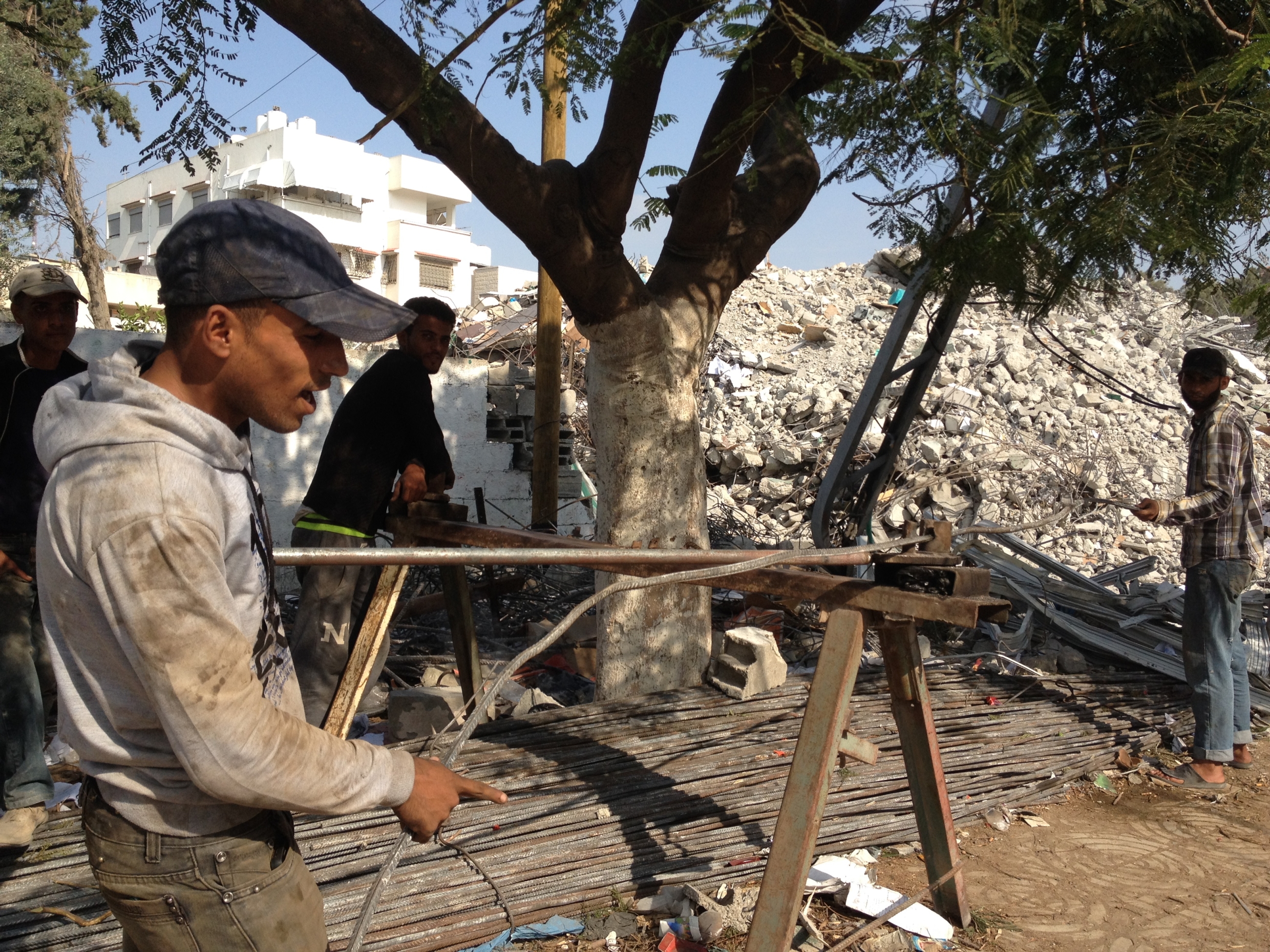A hard day's labour in the ruins of Gaza

GAZA CITY - Under the feet of Yasser Fayyad are the ruins of the Palestinian Finance Ministry and a pile of food stamps, each worth 20 Jordanian dinar ($28), now cancelled after an Israeli F16 destroyed the ministry during 51 days of war this summer. In this rubble, Fayyad, 23, has found a new source of income for his family.
In the past, Gazans who lost their homes to Israeli military attacks would spend their money bringing tractors or donkey carts in to remove rubble, but now Fayyad and others like him use their bare hands, brute force and an odd hammer to clear destroyed neighbourhoods and sell remaining building materials at local markets.
It's not much income for Fayyad and other rubble collectors like him, but the gravel and iron bars from the demolished homes and buildings can be sold again as Gazans aims to rebuild after this summer’s war. Yet a critical element to bind the materials is missing: the cement which Israel won't allow into Gaza.
"The blockade and unemployment has forced me to do this job," said Fayyad as he sweats trying to bend the thick iron construction bars.
Before the war, Fayyad said he used to pay families to let him remove their ruins. With cement crossing through the border at that time, there was high demand for gravel and steel as Gazans rebuilt their homes after the 2008-2009 war. “Now we don’t pay. There is no market for the ruins of destroyed homes,” he said.
It can take Fayyad weeks to dig down into the ruins and remove materials like the gravel and steel, now in short supply as a result of the Israeli blockade. Israeli officials have said such materials will be used for building military facilities. Driven by his family’s needs, Fayyad’s only tool is a hammer that he pounds from 7am to 5pm, with only his thoughts to entertain him.
Despite his long hours, the price Fayyad now receives for found steel has decreased from 3,000 shekels ($782) to 1,500 ($391). "I know there is no high demand for the steel we get out, because there is no cement,” he said.
Hard Labour
The idea to collect reusable rubble started in 2008, when Fayyad, together with his four friends from Beit Hanoun, lost their homes. The four college graduates have managed to pull steel out of all of the buildings destroyed in the 2008-2009 war, he said.
"This is the most difficult job ever,” he said. “This is [the kind of] hard labour criminals are ordered to do when imprisoned." Fayyad said he feels imprisoned in Gaza, forced to do this job from lack of other choices.
Next to Fayyad, Ahmed Shabat uses his sandals to fix an iron bar in preparation for straightening it. "I have no other job, at the end of the day, I have a family to feed, and they need water, and clothing," he said.
"My friends and I completed our universities degrees and we can't find other jobs," Shabat said. One of 11 unemployed brothers, he earns somewhere between 30-40 shekels ($7- $10.50) doing this job, minus 10 shekels ($2.60) he pays for public transportation to and from home. He is left with an average daily wage of around 20 shekels ($5.20). The friends divide their work load and earnings equally at the end of the day.
As the friends work a site, Fayyad receives a phone call from a man who has lost his home in the war, letting Fayyad know that he wants him to remove the ruins of his home with the hope that it might be rebuilt again.
Shabat and Fayyad receive regular calls like this. Though they are based in the norther part of the Gaza Strip, their phone numbers are sprayed all over the enclave on the ruins of demolished homes. They might start a day digging through the ruins of demolished homes facing Israeli military watch-towers in northern Gaza and finish the day in rubble at the Rafah borderline, looking out at Egyptian troops.
Despite the calls from Gazans eager to clear the debris of old homes and make way for the new, Fayyad is fully aware that no real construction will really take place in Gaza any time soon. Many who lost their homes in the 2008-2009 war are still homeless today and they take priority over those who lost their homes this past summer. Everyone is waiting for their lives to be rebuilt.
Walking through the rubble of the man who just called him, Fayyad tells him he is busy even though the man said he is willing to pay Fayyad and the team money to take away the ruins of his home, demolished when an Israeli airstrike hit following a ‘knock on the roof’ warning missile. Several family members were injured in the attack, he said.
He would now like to clear the debris, left since the strike, to make room for pre-fabricated huts which aid agencies promise to send.
Hundreds of Gazans in Shejayeh, like this man, are homeless and asking for the same tents and pre-fabricated huts they want to erect in order to maintain ownership of and and continue to live on their land.
Waiting for cement
As Fayyad and Shabat have rolled with the ups and downs of supply and demand and open and closed borders, they have adapted their techniques to improve their business. To bare hands and a hammer, they added a small manual machine that they developed which helps form found steel into manageable shapes.
"When we started doing this, people started to express demand for the steel and gravel we were extracting," Shabat said. "Not everyone has the patience to straighten steel previously ruined by F16s."
Shabat directs all of the young men working on site to carry a massive pillar. "A pillar of concrete like this could take me two days to smash into smaller pieces," he said, his hands shaking from its heavy weight.
One of the most daunting tasks ahead is to trawl through the ruins of a 12-story apartment tower quite literally with their bare hands. Fayyad, like his co-workers knows the job they do is a form of forced hard labour. They continue on in order to make a basic living and feed their families, knowing there are many long days ahead as they attempt to remove the steel from thousands of destroyed homes – and wait for cement.
"We can only sell steel once cement is allowed through to Gaza," Fayyad said, gazing at piles of wedding congratulation letters laying under the ruins of a demolished home.
One thing you can be sure of: either the bride or her friend is homeless, if they are lucky enough to still be alive, he said.
Middle East Eye propose une couverture et une analyse indépendantes et incomparables du Moyen-Orient, de l’Afrique du Nord et d’autres régions du monde. Pour en savoir plus sur la reprise de ce contenu et les frais qui s’appliquent, veuillez remplir ce formulaire [en anglais]. Pour en savoir plus sur MEE, cliquez ici [en anglais].




